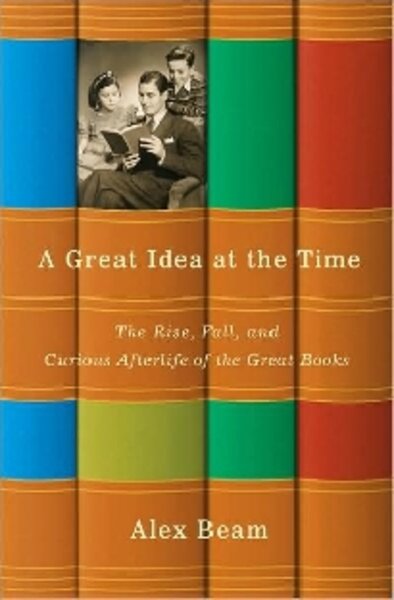A Great Idea at the Time
Loading...
Did you read “Treatise on Conic Sections” by Apollonius of Perga in college? What about works of Epictetus? Plato, at least? If you didn’t, and you’re feeling pangs of intellectual inferiority, don’t despair. You can still buy the “Great Books of the Western World.”
A million American households did, and you, too, can experience the thrill of watching the canon of Western civilization attract envious stares from your neighbors – and collect dust.
The Great Books enterprise is both an educational method and a for-sale anthology. Proponents imbued it with near-salvific power; amid a sea of declining standards, it would be the sheet anchor of Western heritage. Critics saw it as pretentious pedagogy or as cultural succor huckstered to an insecure middle class.
Alex Beam, a columnist for The Boston Globe, gives both sides a fair hearing in his breezy and lucid account, A Great Idea at the Time.
Though the Great Books is today remembered as a mid-20th century fad – Britannica salesmen literally peddled it door-to-door – Mr. Beam reminds us that the phenomenon began as an academic backlash.
Up until the late 1800s, students at Harvard and Yale took virtually the same courses all four years. Greek, Latin, Math. Rinse, Lather, Repeat. Then condition with Chemistry, Physics, and Rhetoric. If that sounds positively medieval, it’s because it was medieval.
But Harvard President Charles Eliot scrapped this tradition. By 1899, Harvard had moved to an all-elective curriculum. The course “catalog” was born. Suddenly, students across America were consumers.
Most young people probably welcomed this change. Not Robert Hutchins, John Erskine, and Mortimer Adler. These three intellectuals felt that the elective system deprived young people of the opportunity – nay, the need! – to grasp the ideas of history’s supreme thinkers. The dynamic duo of Hutchins and Adler made it a major part of their life’s work to evangelize the Great Books.
The aim of higher education, Hutchins held, was no less than metaphysics. “Wisdom is knowledge of principles and causes,” he wrote. “Metaphysics deals with the highest principles and causes. Therefore metaphysics is the first wisdom.”
Such a lofty pursuit demanded the right classroom method. So they insisted on Socratic, or shared, inquiry among a small group of students and their teacher.
In the 1930s, as the boy-wonder president of the University of Chicago, Hutchins strove vigorously – often against bitter opposition – to restructure the curriculum to reflect his ideal.
Similar efforts were under way at Columbia University.
On a separate track, the movement reached outside campus walls by offering Great Books discussion groups to the community’s movers and shakers – but also to the common man. (Epictetus for executives! Gibbon for garbagemen! Milton for mothers!) This outreach was the product of Hutchins’s belief that “the best education for the best is the best education for all.”
This noble impulse, though, didn’t stop proponents from seeking great bucks from the Great Books. Here, Beam’s history shines.
He captures the ironic – even ludicrous – contours of the great book’s rocky path to commercial success and eventual obscurity: The pompous launch. The million-dollar making of Adler’s special index, the – try not to laugh – “Syntopicon.” (Envious, Harvard soon created an “Indexicon” for its anthology of classics.)
Today, the Great Books live on mostly through discussion groups. Some top-notch colleges still require a modest exposure to some of the “greats.”
But the founders’ dream that higher education would once again orient itself toward Western truth never materialized. Except, that is, at tiny St. John’s College, where the curriculum consists only of the great books. Even science labs are restricted to the experiments of ancient worthies such as Ptolemy.
That’s hard core, and Beam can’t decide if he’s impressed or bemused.
Beam’s text is commendably concise, but I do wish he had devoted more space to pondering – instead of merely raising – important questions about the great books themselves: Can a modern reader “talk” intelligibly with the greats in translation?
Can a classic text truly speak for itself – or should historical and biographical context, along with modern annotations, be incorporated?
Aren’t some of the great books also some of the worst, in terms of the destructive power of their ideas? Most important, what is the purpose of higher education – and does that purpose require a classical curriculum core?
At bottom, Beam’s excellent book is about much more than a passing fad; it’s a pithy primer to one of the most important debates in educational history.
Josh Burek is the Monitor’s Opinion Page editor.






